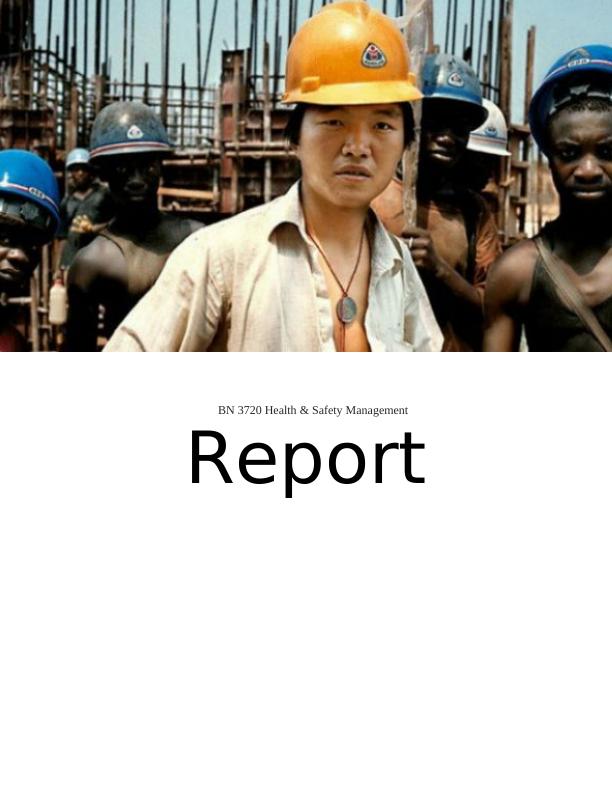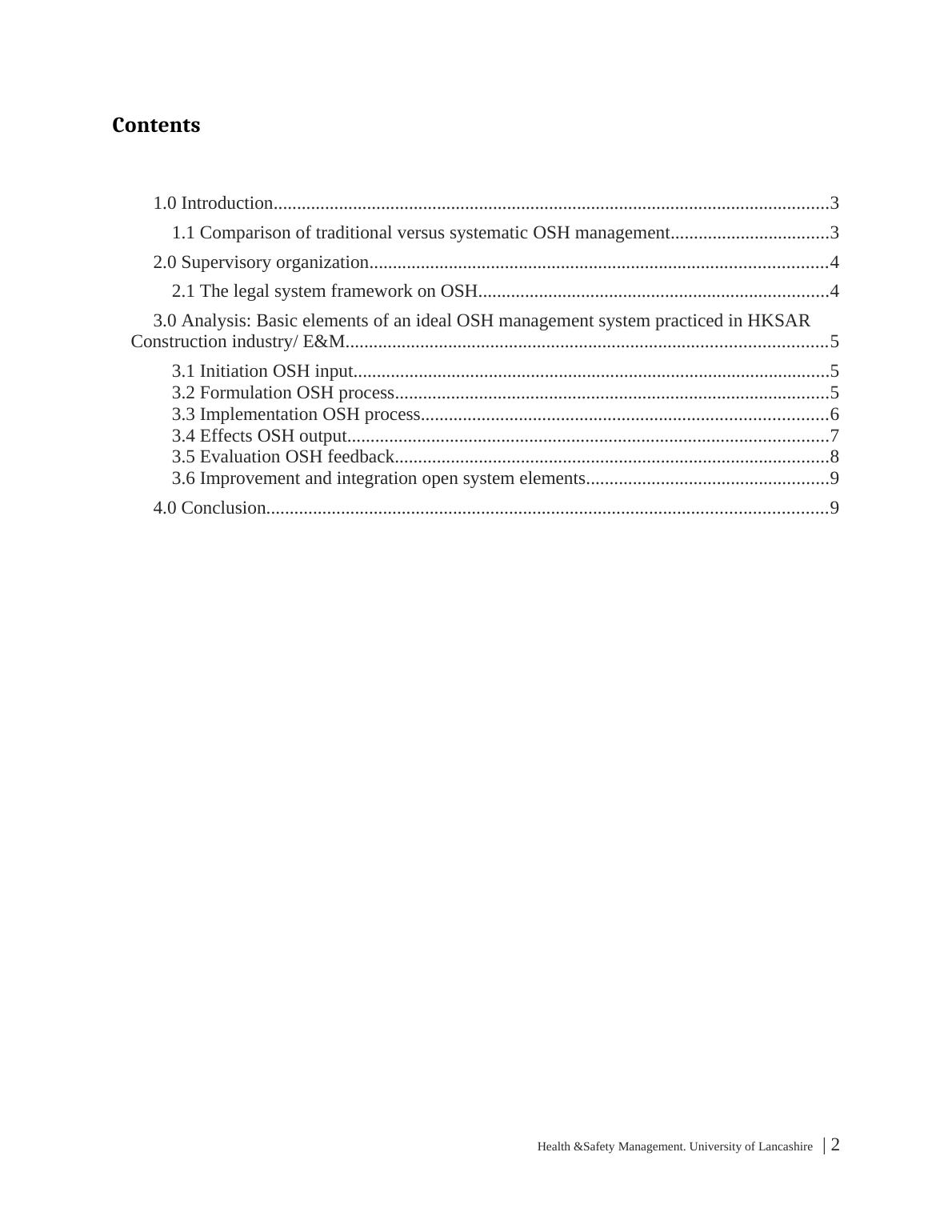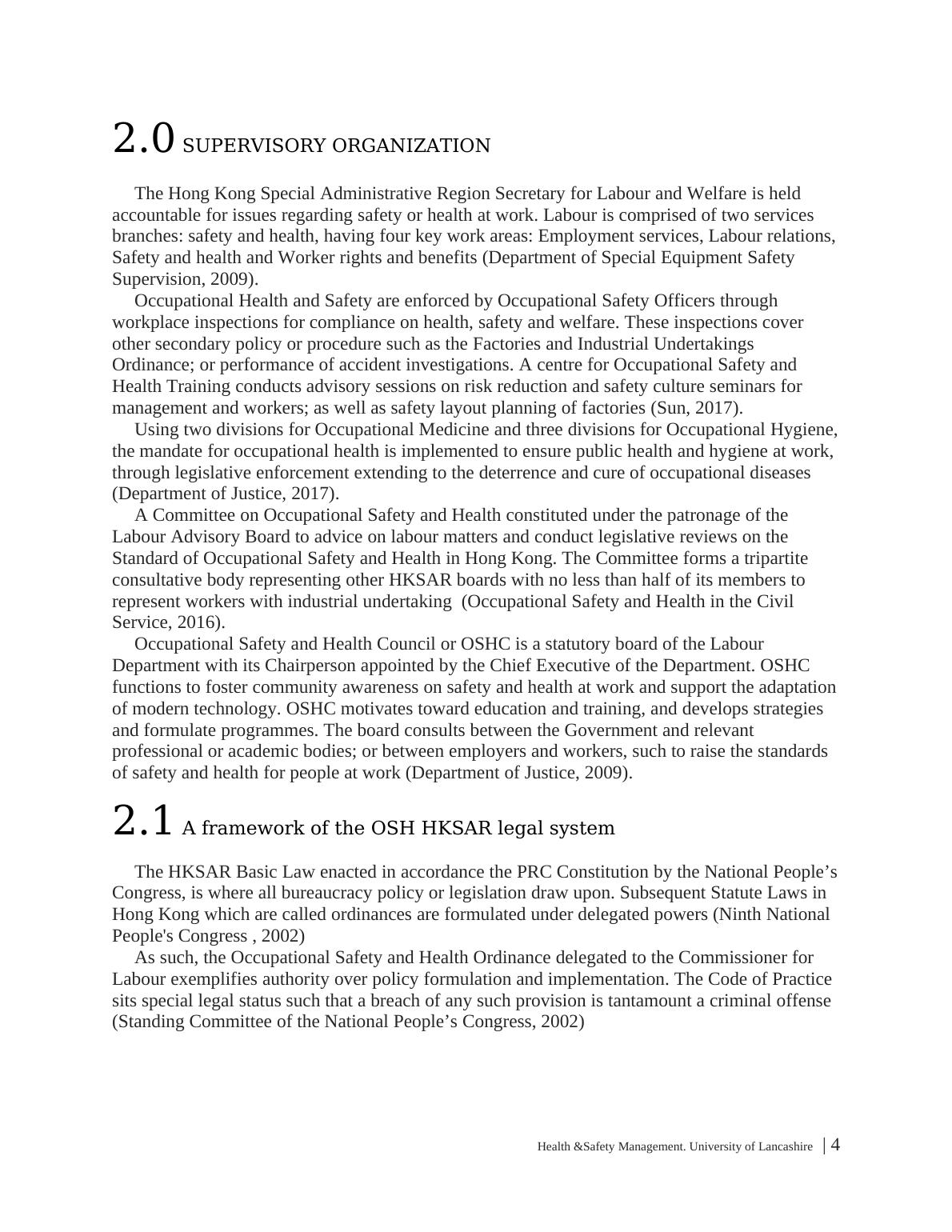Comparison of Traditional vs Systematic OSH Management
Added on 2023-01-16
11 Pages3451 Words1 Views
BN 3720 Health & Safety Management
Report
Report

Contents
1.0 Introduction.......................................................................................................................3
1.1 Comparison of traditional versus systematic OSH management..................................3
2.0 Supervisory organization..................................................................................................4
2.1 The legal system framework on OSH...........................................................................4
3.0 Analysis: Basic elements of an ideal OSH management system practiced in HKSAR
Construction industry/ E&M.......................................................................................................5
3.1 Initiation OSH input......................................................................................................5
3.2 Formulation OSH process.............................................................................................5
3.3 Implementation OSH process.......................................................................................6
3.4 Effects OSH output.......................................................................................................7
3.5 Evaluation OSH feedback.............................................................................................8
3.6 Improvement and integration open system elements....................................................9
4.0 Conclusion........................................................................................................................9
Health &Safety Management. University of Lancashire | 2
1.0 Introduction.......................................................................................................................3
1.1 Comparison of traditional versus systematic OSH management..................................3
2.0 Supervisory organization..................................................................................................4
2.1 The legal system framework on OSH...........................................................................4
3.0 Analysis: Basic elements of an ideal OSH management system practiced in HKSAR
Construction industry/ E&M.......................................................................................................5
3.1 Initiation OSH input......................................................................................................5
3.2 Formulation OSH process.............................................................................................5
3.3 Implementation OSH process.......................................................................................6
3.4 Effects OSH output.......................................................................................................7
3.5 Evaluation OSH feedback.............................................................................................8
3.6 Improvement and integration open system elements....................................................9
4.0 Conclusion........................................................................................................................9
Health &Safety Management. University of Lancashire | 2

1.0 INTRODUCTION
ILO estimates the construction industry to have as many as sixty thousand disastrous
occupational accidents, which makes up roughly seventeen percent of per annum of 45 million
non-fatal accidents (Ncube, 2018). The industry accounts ten percent of worldwide employment
or nearly 110 million construction workers; which equate to a single deadly accident every ten
minutes and serious accident per second to be more.
Occupational Safety and Health practices or OSH Management, serve as a good indicator of
advancement in urban areas. The wellbeing of the worker has gradually taken shape across
industries throughout the world: Safety engineering and industrial hygiene among others. The
evolution of China’s OSH regulatory system is manifested in the business implements
throughout the country. One of China’s special administrative regions is Hong Kong, having
similarities and cross-cultural distinctions between International Standards, or even that of
Mainland China.
1.1 Comparison of traditional versus systematic OSH management
Inspired by the European Robens Committee report, the traditional prescriptive methods for
Occupational Safety and Health has transformed in the 20th century through a number of
regulatory reforms introduced (Targoutzidis, 2014). At the international scale, OSH ILO defined
its global strategy in June 2003 then underlined the importance of ‘sound management of safety
and health at work,’ in a framework adopted in June 2006 (International Labour Organisation,
2006).
Motivation Responsibility Evaluation Typical goals Outputs
Traditional
OSH
management
Sidestepping
penalty
OSH
professionals
External
examination
Sidestepping
penalty
Restricted
control of work-
related risks
Legal
requirements
not effusively
effected
Systematic
OSH
Management
Benefits
subsequent
improved
performance
All employees Monitoring and
examining
Incessant
improvement
Operative
control of
occupational
risks
Repeatedly
exceeding legal
requirements
Table 1: Traditional versus systematic OSH management (Goggin, 2010)
Health &Safety Management. University of Lancashire | 3
ILO estimates the construction industry to have as many as sixty thousand disastrous
occupational accidents, which makes up roughly seventeen percent of per annum of 45 million
non-fatal accidents (Ncube, 2018). The industry accounts ten percent of worldwide employment
or nearly 110 million construction workers; which equate to a single deadly accident every ten
minutes and serious accident per second to be more.
Occupational Safety and Health practices or OSH Management, serve as a good indicator of
advancement in urban areas. The wellbeing of the worker has gradually taken shape across
industries throughout the world: Safety engineering and industrial hygiene among others. The
evolution of China’s OSH regulatory system is manifested in the business implements
throughout the country. One of China’s special administrative regions is Hong Kong, having
similarities and cross-cultural distinctions between International Standards, or even that of
Mainland China.
1.1 Comparison of traditional versus systematic OSH management
Inspired by the European Robens Committee report, the traditional prescriptive methods for
Occupational Safety and Health has transformed in the 20th century through a number of
regulatory reforms introduced (Targoutzidis, 2014). At the international scale, OSH ILO defined
its global strategy in June 2003 then underlined the importance of ‘sound management of safety
and health at work,’ in a framework adopted in June 2006 (International Labour Organisation,
2006).
Motivation Responsibility Evaluation Typical goals Outputs
Traditional
OSH
management
Sidestepping
penalty
OSH
professionals
External
examination
Sidestepping
penalty
Restricted
control of work-
related risks
Legal
requirements
not effusively
effected
Systematic
OSH
Management
Benefits
subsequent
improved
performance
All employees Monitoring and
examining
Incessant
improvement
Operative
control of
occupational
risks
Repeatedly
exceeding legal
requirements
Table 1: Traditional versus systematic OSH management (Goggin, 2010)
Health &Safety Management. University of Lancashire | 3

2.0 SUPERVISORY ORGANIZATION
The Hong Kong Special Administrative Region Secretary for Labour and Welfare is held
accountable for issues regarding safety or health at work. Labour is comprised of two services
branches: safety and health, having four key work areas: Employment services, Labour relations,
Safety and health and Worker rights and benefits (Department of Special Equipment Safety
Supervision, 2009).
Occupational Health and Safety are enforced by Occupational Safety Officers through
workplace inspections for compliance on health, safety and welfare. These inspections cover
other secondary policy or procedure such as the Factories and Industrial Undertakings
Ordinance; or performance of accident investigations. A centre for Occupational Safety and
Health Training conducts advisory sessions on risk reduction and safety culture seminars for
management and workers; as well as safety layout planning of factories (Sun, 2017).
Using two divisions for Occupational Medicine and three divisions for Occupational Hygiene,
the mandate for occupational health is implemented to ensure public health and hygiene at work,
through legislative enforcement extending to the deterrence and cure of occupational diseases
(Department of Justice, 2017).
A Committee on Occupational Safety and Health constituted under the patronage of the
Labour Advisory Board to advice on labour matters and conduct legislative reviews on the
Standard of Occupational Safety and Health in Hong Kong. The Committee forms a tripartite
consultative body representing other HKSAR boards with no less than half of its members to
represent workers with industrial undertaking (Occupational Safety and Health in the Civil
Service, 2016).
Occupational Safety and Health Council or OSHC is a statutory board of the Labour
Department with its Chairperson appointed by the Chief Executive of the Department. OSHC
functions to foster community awareness on safety and health at work and support the adaptation
of modern technology. OSHC motivates toward education and training, and develops strategies
and formulate programmes. The board consults between the Government and relevant
professional or academic bodies; or between employers and workers, such to raise the standards
of safety and health for people at work (Department of Justice, 2009).
2.1 A framework of the OSH HKSAR legal system
The HKSAR Basic Law enacted in accordance the PRC Constitution by the National People’s
Congress, is where all bureaucracy policy or legislation draw upon. Subsequent Statute Laws in
Hong Kong which are called ordinances are formulated under delegated powers (Ninth National
People's Congress , 2002)
As such, the Occupational Safety and Health Ordinance delegated to the Commissioner for
Labour exemplifies authority over policy formulation and implementation. The Code of Practice
sits special legal status such that a breach of any such provision is tantamount a criminal offense
(Standing Committee of the National People’s Congress, 2002)
Health &Safety Management. University of Lancashire | 4
The Hong Kong Special Administrative Region Secretary for Labour and Welfare is held
accountable for issues regarding safety or health at work. Labour is comprised of two services
branches: safety and health, having four key work areas: Employment services, Labour relations,
Safety and health and Worker rights and benefits (Department of Special Equipment Safety
Supervision, 2009).
Occupational Health and Safety are enforced by Occupational Safety Officers through
workplace inspections for compliance on health, safety and welfare. These inspections cover
other secondary policy or procedure such as the Factories and Industrial Undertakings
Ordinance; or performance of accident investigations. A centre for Occupational Safety and
Health Training conducts advisory sessions on risk reduction and safety culture seminars for
management and workers; as well as safety layout planning of factories (Sun, 2017).
Using two divisions for Occupational Medicine and three divisions for Occupational Hygiene,
the mandate for occupational health is implemented to ensure public health and hygiene at work,
through legislative enforcement extending to the deterrence and cure of occupational diseases
(Department of Justice, 2017).
A Committee on Occupational Safety and Health constituted under the patronage of the
Labour Advisory Board to advice on labour matters and conduct legislative reviews on the
Standard of Occupational Safety and Health in Hong Kong. The Committee forms a tripartite
consultative body representing other HKSAR boards with no less than half of its members to
represent workers with industrial undertaking (Occupational Safety and Health in the Civil
Service, 2016).
Occupational Safety and Health Council or OSHC is a statutory board of the Labour
Department with its Chairperson appointed by the Chief Executive of the Department. OSHC
functions to foster community awareness on safety and health at work and support the adaptation
of modern technology. OSHC motivates toward education and training, and develops strategies
and formulate programmes. The board consults between the Government and relevant
professional or academic bodies; or between employers and workers, such to raise the standards
of safety and health for people at work (Department of Justice, 2009).
2.1 A framework of the OSH HKSAR legal system
The HKSAR Basic Law enacted in accordance the PRC Constitution by the National People’s
Congress, is where all bureaucracy policy or legislation draw upon. Subsequent Statute Laws in
Hong Kong which are called ordinances are formulated under delegated powers (Ninth National
People's Congress , 2002)
As such, the Occupational Safety and Health Ordinance delegated to the Commissioner for
Labour exemplifies authority over policy formulation and implementation. The Code of Practice
sits special legal status such that a breach of any such provision is tantamount a criminal offense
(Standing Committee of the National People’s Congress, 2002)
Health &Safety Management. University of Lancashire | 4

End of preview
Want to access all the pages? Upload your documents or become a member.
Related Documents
BN3720 Health & Safety Management | Worker Registration System Assessment in Hong Kong Among Construction Workerslg...
|10
|3531
|24
